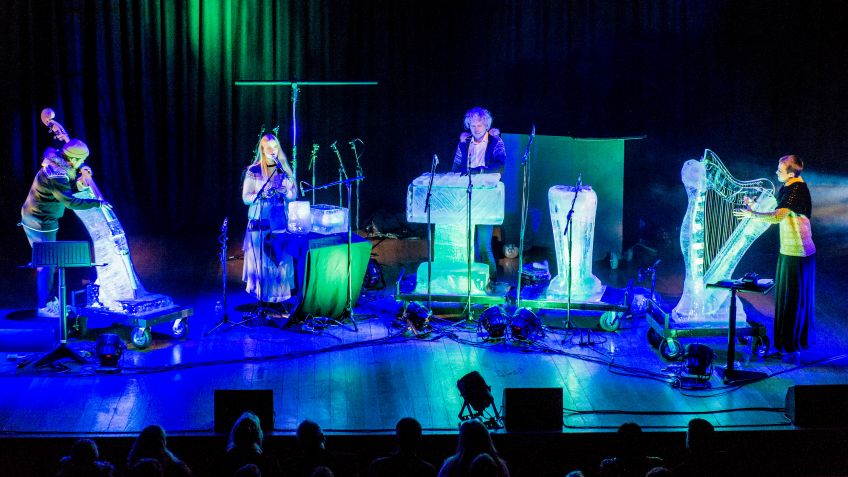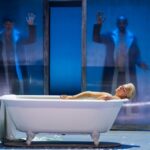Fancy a concert played on instruments carved and sculpted out of ice? Oh, yes, it can be done, and Terje Isungset’s Ice Quartet shows just how. In 1999, the Norwegian percussionist, pioneer of musical innovation and champion of Nature, moved on from exploring ranges of sounds he might coax from natural materials like wood and stone to exploring sounds he might coax from ice that’s moulded into different shapes and forms that, when struck or blown, might sing and resound both acoustically and when gloriously amplified.
Before the music even begins, though, the complex logistics of setting up colossal icy instruments on a stage lit with icy-realm blue, purple, pink, hints of lime and dry-ice mists is a performance in itself. As heavy-laden trollies heave along, carrying covered instruments to their places, each revelation amazes the audience. Of course, it’s not possible to set out every component at the start and leave it there throughout, not when instruments melt, so players and assistants constantly come and go, bringing out and assembling freshly frozen components and covering or removing ones that have just been used. And since there’s always a good deal of unpredictability when it comes to temperatures and melting (as confirmed at COP 30) players must always be prepared for the unexpected. When a portion of Terje’s ice xylophone crashed to the floor and broke in half he just kept his cool, kept calm and carried on playing on what was left. Striking with mittened hands (different ones eliciting different sounds from the ice) or using ice drumsticks, he creates hollow tones, chimes, rings and singings on blocks, tubes and mashings of ice, great and small, in the forms of xylophone/marimba, dangling tubular ice-bells, drum surfaces or pestle and mortar. These are interspersed with animal cries from a Viking ice-horn and a giant trombone bell of ice, whose amplified, elephantine whale calls resound in the air or whose tight, high-pitched squeezings fight hard to escape.
The backbone of the music, though, is produced on ice-harp, played by Julie Rokseth, and ice-bass, plucked, slapped and bowed by Toive Tjose and by the airy, ethereal vocals from Amalie Holt Klieve who also inputs sounds of pouring water into which she blows via an elaborate straw, besides donning mittens to add to Terje’s icy, percussive mix.

Though the bodies of harp and double bass are shaped from heavy, glistening ice, both, of course, sport strings that are played, thankfully, without the encumbrance of gloves. Both add further innovative, avant-garde variety to the laid-back, delicate, other-wordly music as when the harp is slapped and patted or has a long length of tape drawn across a string, or when the bass is bowed to create bellyache growlings or high-pitched animal screechings and creakings. Mainly, though, they maintain an unhurried jazz/folk feel to accompany the floating, breathy vocals, which are generally free of lyrics and full of skatty, airy soprano hah-ah-do-ah-da elements. There are certainly no medleys from Frozen and Handel never did progress from Water Music to Ice Music so he doesn’t feature either. Mozart surely would have been up for it, though, just as he was for composing for the singing, crystal tones of Benjamin Franklin’s glass armonica, invented in 1761, in which a long series of interconnected glass bowls of graduated sizes rotate as a single, icy-looking carrot-shaped instrument, played delicately with wet fingers.
As much as being about music and tone poems, the performance is particularly about the experience of visual spectacle, all mightily enhanced by the echoing, reverberating wonders of sound engineering and by the intrigue created by the whole concept. That humans are small and insignificant is the message, while Nature is all-important. Indeed, haunting whale, seal and polar bear calls, snufflings and wailing cries, recorded undersea, are incorporated and replicated in the music. ‘Take away the memory of the music and the experience’, Terje says (plus a CD if you want to buy one). Seeing musicians clad in cool colours and sporting various Scandi or fluffy jumpers, fur-edged hoods, wool hats, long, silken skirt and/or mittens is a phenomenon in itself, though the audience, fortunately, is in no danger of frost-bite if not too flimsily clad.
Since 2006, Norway has held an Ice Festival and Terje has created music in collaboration with various orchestras and combos. Maybe his next challenge should be to make music from the frozen waters of Lake Windermere rather than from crystalline Norwegian sources. What dark, heavy songs they might sing, for they certainly have a tale to tell about the role of humans and the importance of Nature. But it may not be such a pretty sight.
To avoid melt-down there’s no interval, of course, and the instruments are rushed to their freezer asap at the end of an intriguing evening of uniquely cool music.
Eileen Caiger Gray




